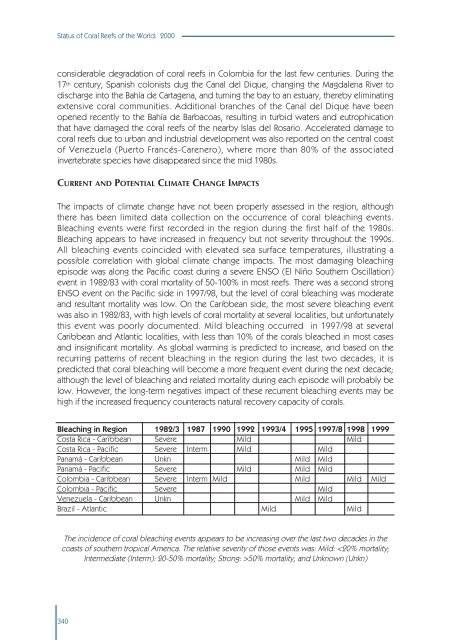Status of Coral Reefs of the World 2000
Status of Coral Reefs of the World 2000.pdf
Status of Coral Reefs of the World 2000.pdf
- No tags were found...
Create successful ePaper yourself
Turn your PDF publications into a flip-book with our unique Google optimized e-Paper software.
<strong>Status</strong> <strong>of</strong> <strong>Coral</strong> <strong>Reefs</strong> <strong>of</strong> <strong>the</strong> <strong>World</strong>: <strong>2000</strong><br />
considerable degradation <strong>of</strong> coral reefs in Colombia for <strong>the</strong> last few centuries. During <strong>the</strong><br />
17 th century, Spanish colonists dug <strong>the</strong> Canal del Dique, changing <strong>the</strong> Magdalena River to<br />
discharge into <strong>the</strong> Bahía de Cartagena, and turning <strong>the</strong> bay to an estuary, <strong>the</strong>reby eliminating<br />
extensive coral communities. Additional branches <strong>of</strong> <strong>the</strong> Canal del Dique have been<br />
opened recently to <strong>the</strong> Bahía de Barbacoas, resulting in turbid waters and eutrophication<br />
that have damaged <strong>the</strong> coral reefs <strong>of</strong> <strong>the</strong> nearby Islas del Rosario. Accelerated damage to<br />
coral reefs due to urban and industrial development was also reported on <strong>the</strong> central coast<br />
<strong>of</strong> Venezuela (Puerto Francés-Carenero), where more than 80% <strong>of</strong> <strong>the</strong> associated<br />
invertebrate species have disappeared since <strong>the</strong> mid 1980s.<br />
CURRENT AND POTENTIAL CLIMATE CHANGE IMPACTS<br />
The impacts <strong>of</strong> climate change have not been properly assessed in <strong>the</strong> region, although<br />
<strong>the</strong>re has been limited data collection on <strong>the</strong> occurrence <strong>of</strong> coral bleaching events.<br />
Bleaching events were first recorded in <strong>the</strong> region during <strong>the</strong> first half <strong>of</strong> <strong>the</strong> 1980s.<br />
Bleaching appears to have increased in frequency but not severity throughout <strong>the</strong> 1990s.<br />
All bleaching events coincided with elevated sea surface temperatures, illustrating a<br />
possible correlation with global climate change impacts. The most damaging bleaching<br />
episode was along <strong>the</strong> Pacific coast during a severe ENSO (El Niño Sou<strong>the</strong>rn Oscillation)<br />
event in 1982/83 with coral mortality <strong>of</strong> 50-100% in most reefs. There was a second strong<br />
ENSO event on <strong>the</strong> Pacific side in 1997/98, but <strong>the</strong> level <strong>of</strong> coral bleaching was moderate<br />
and resultant mortality was low. On <strong>the</strong> Caribbean side, <strong>the</strong> most severe bleaching event<br />
was also in 1982/83, with high levels <strong>of</strong> coral mortality at several localities, but unfortunately<br />
this event was poorly documented. Mild bleaching occurred in 1997/98 at several<br />
Caribbean and Atlantic localities, with less than 10% <strong>of</strong> <strong>the</strong> corals bleached in most cases<br />
and insignificant mortality. As global warming is predicted to increase, and based on <strong>the</strong><br />
recurring patterns <strong>of</strong> recent bleaching in <strong>the</strong> region during <strong>the</strong> last two decades, it is<br />
predicted that coral bleaching will become a more frequent event during <strong>the</strong> next decade;<br />
although <strong>the</strong> level <strong>of</strong> bleaching and related mortality during each episode will probably be<br />
low. However, <strong>the</strong> long-term negatives impact <strong>of</strong> <strong>the</strong>se recurrent bleaching events may be<br />
high if <strong>the</strong> increased frequency counteracts natural recovery capacity <strong>of</strong> corals.<br />
Bleaching in Region 1982/3 1987 1990 1992 1993/4 1995 1997/8 1998 1999<br />
Costa Rica - Caribbean Severe Mild Mild<br />
Costa Rica - Pacific Severe Interm Mild Mild<br />
Panamá - Caribbean Unkn Mild Mild<br />
Panamá - Pacific Severe Mild Mild Mild<br />
Colombia - Caribbean Severe Interm Mild Mild Mild Mild<br />
Colombia - Pacific Severe Mild<br />
Venezuela - Caribbean Unkn Mild Mild<br />
Brazil - Atlantic Mild Mild<br />
The incidence <strong>of</strong> coral bleaching events appears to be increasing over <strong>the</strong> last two decades in <strong>the</strong><br />
coasts <strong>of</strong> sou<strong>the</strong>rn tropical America. The relative severity <strong>of</strong> those events was: Mild: 50% mortality, and Unknown (Unkn)<br />
340
















